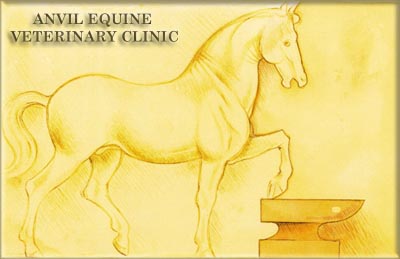TENDON SHEATH & JOINT INFECTIONS
Liz Brown, MRCVS
Infections of tendon sheaths and joints are serious and potentially
fatal conditions. They are also a relatively common condition.
We normally see these as a result of injuries such as cuts,
lacerations, puncture and overreach wounds in the vicinity of
a joint or tendon sheath.
The horse has many joints and tendon sheaths that are very
close to the skin surface and therefore liable to injury or
penetration. Any wound that is close to a joint or tendon sheath
should be treated seriously and the vet called if there is any
doubt about the possibility of penetration. In some cases synovial
fluid (fluid from the joint or tendon sheath), which is clear
or straw coloured can be seen leaking from a wound but this
is not apparent in many cases.
When synovial structures (joints or tendon sheaths) are penetrated
bacteria enter the cavity and start to multiply. Multiplication
of bacteria within the joint results in severe inflammation
and infection. If left untreated joint or tendon sheath infections
will result in a severe lameness, which sometimes can develop
over a few hours, in other cases over 24hours. So if your horse
appears to have a small fairly insignificant wound one day and
be hopping lame the next, tendon sheath or joint infection could
be a distinct possibility and the vet should be contacted immediately.
Treatment for joint or tendon sheath infections involves flushing
the joint with large quantities of sterile fluid to remove bacteria.
Antibiotics by themselves will not penetrate into the synovial
fluid sufficiently to clear the infection. Flushing of the joint
is performed through needles or by arthroscopy. Arthroscopy
is the treatment of choice for most joint or tendon sheath infections.
This involves inserting a camera into the joint, which allows
visualisation of the inside of the joint or tendon sheath and
removal of any foreign bodies, damaged or infected tissue and
inflamed synovial lining. This is performed under general anaesthesia.
It allows for a better flush than can usually be achieved with
needles. A needle flush is appropriate for very recent wounds
which can be flushed before bacteria have had time to establish
themselves within the joint. In many cases an arthroscopy may
be necessary in addition to fully assess and clean the joint.
There is a so called “golden period” following joint
or tendon sheath penetration during which bacteria are present
in the joint but have not had sufficient time to multiply and
establish an infection. If the joint or tendon sheath is flushed
within this time period there is a better chance of cleaning
up the joint before bacterial numbers multiply. This period
is traditionally quoted as 6-8 hours but does depend on the
degree of contamination of the joint by bacteria. Since many
horses injure themselves in the field it is often not known
exactly how long the wound has been present. However the longer
an infection has been established prior to treatment the more
difficult it will be to clear up without recurrence.
Following surgery most horses are kept on intravenous antibiotics
for five days. In some cases it is possible for infection to
recur in the joint or tendon sheath which would require further
surgery.
Some penetrative injuries involve other structures such as
the tendons, areas of bone or cartilage within the joint or
ligaments around the joint. The degree of injury to such structures
will affect the recovery period and the long term prognosis
even if the infection is cleared up successfully.
If left untreated tendon sheath and joint infections usually
result in a severe permanent lameness, which will often necessitate
euthanasia. For this reason it is of the utmost importance to
assess and treat these injuries quickly. If in any doubt phone
the vet!
Liz Brown, MRCVS
Anvil Vets:
Anvil Equine Veterinary Clinic, Tuckmans
Farm, Copsale, Horsham, West Sussex RH13 7DL
Tel: 01403 731 213 Fax: 01403 733992
Email anvilvets@freeuk.com
Return to Top
VISIT
ANVIL EQUINE VETERINARY CLINIC'S HOMEPAGE
